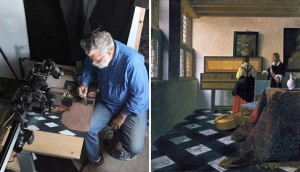Related to CC201’s study of Rembrandt is the mysterious work of Johannes Vermeer, another painter of the Dutch Golden Age. His photo-realism has been a topic of debate – how did he achieve it? Vanity Fair offers some recent speculation. Here is a sample:
Despite occasional speculation over the years that an optical device somehow enabled Vermeer to paint his pictures, the art-history establishment has remained adamant in its romantic conviction: maybe he was inspired somehow by lens-projected images, but his only exceptional tool for making art was his astounding eye, his otherworldly genius.
At the beginning of this century, however, two experts of high standing begged to differ. Why, for instance, did Vermeer paint things in the foreground and shiny highlights on objects slightly out of focus? Because, they say, he was looking at them through a lens. By itself, Vermeer’s Camera: Uncovering the Truth Behind the Masterpieces, by a London architecture professor named Philip Steadman, might have stirred a minor academic fuss. But a mainstream controversy was provoked—conferences, headlines, outrage, name-calling—because a second, more sweeping and provocative argument was made by one of the most famous living painters, David Hockney. Hockney argued in Secret Knowledge: Rediscovering the Lost Techniques of Old Masters that not only Vermeer but many great painters from the 15th century onward must have secretly used lens-and-mirror contraptions to achieve their photo-realistic effects.
…
The crux of the resistance to the idea that Vermeer invented and used an optical device, beyond technical and historiographic issues, is that it diminishes our sense of Vermeer’s genius. But great artists in every age use clever new tools and technologies. You could give all the digital contraptions Alfonso Cuarón used on Gravity to a hack director and he’d make a crappy movie. Pro Tools software doesn’t turn a mediocre musician into a great one, but great ones depend on it. Chuck Close bases paintings on photographs and uses a mechanical lift to move his enormous canvases around as he works on them. As Jenison says of the history of art, “perspective is an algorithm, a ‘device’” invented in the 15th century to paint more realistic illusions.
For the full article, visit Vanity Fair.


One Trackback
[…] numerous paintings are works of Rubens and Rembrandt, whom we study in CC202, and Vermeer, who has featured on this blog […]